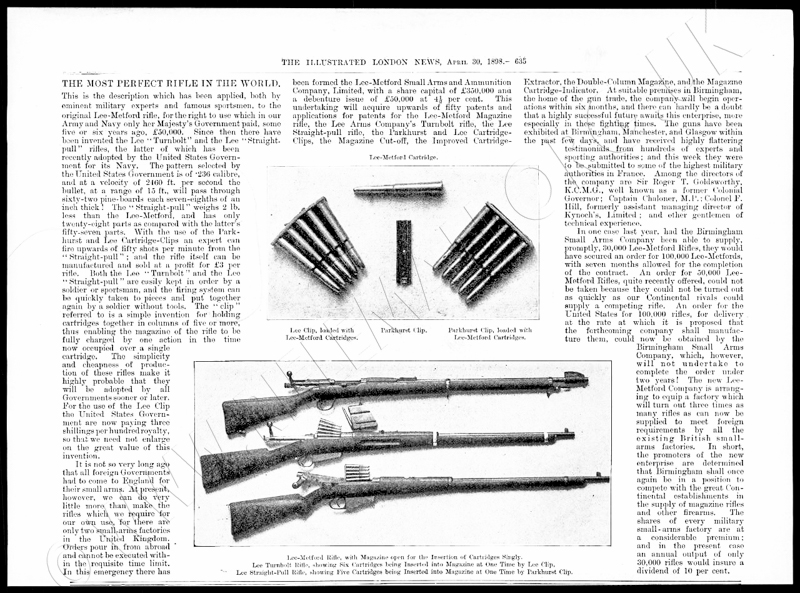THIS IS THE U.K. HISTORIC ARMS RESOURCE CENTRE ......... .FREE OF COOKIES, TRACKING & ADVERTISEMENTS
The Magazine Lee-Metford and Lee-Enfield Rifles Mk.1*
or "Long Lee" M.L.M. and M.L.E. Mk.1*
by the B.S.A. & M. Co.
(Birmingham Small Arms & Metal Company)
In the reign of Victoria Regina - 1892
See also a "Long" Lee-Enfield training rifle in .22RF
and the M.L.E. in the air with the Royal Flying Corps during WW1
N.B. - The original drawings for these rifles and carbines, and detailed notes are available on our page for INSTRUCTIONS FOR ARMOURERS 1897
Under the above name, B.S.A. was incorporated in 1873, and dissolved in 1916, mid Great War.
The illustrated rifle is a Magazine Lee-Metford (M.L.M.) dated 1892, of between First and Second Boer Wars vintage. These Lee-Metfords and Lee-Enfields had yet to be converted for charger loading, resulting in the later nomenclature of C.L.L.E and C.L.L.M rifles
The next image can be rotated and zoomed, either as initially loaded or full-screen for higher definition.
The rifle is fitted with both the bolt cover and bolt-head with incorporated shroud of the early issue rifles. The bolt cocking-piece does not carry the safety catch added to later Mark II* Metford and M.L.E rifles. Note also the grooved fore-end woodwork, including the small notch below the cut-off (to clear the thumb when changing between single-loading and magazine-feeding), and the round-nosed magazine with retaining link at the front. The fore-sight is the standard plain and unprotected barleycorn. The rear-sight leaf is calibrated to 1,700 yards. The front and rear volley sights remain in place.
The butt-stock has had the initials 'H.J.' carved into the right-hand-side ahead of the unstamped butt disc. The nose-cap includes the bayonet-lug for the 1888 Mk.I (1st. type) bayonet and is bored for a cleaning rod (omitted in later production). The front barrel band, pinning the nose-cap, retains both the front sling swivel and the open "stacking" or "piling" loop swivel.
Below: top - the Mk.I 1st. type with triple rivetted grips, and
bottom - the more common Mk.I 2nd. type, each with its scabbard.
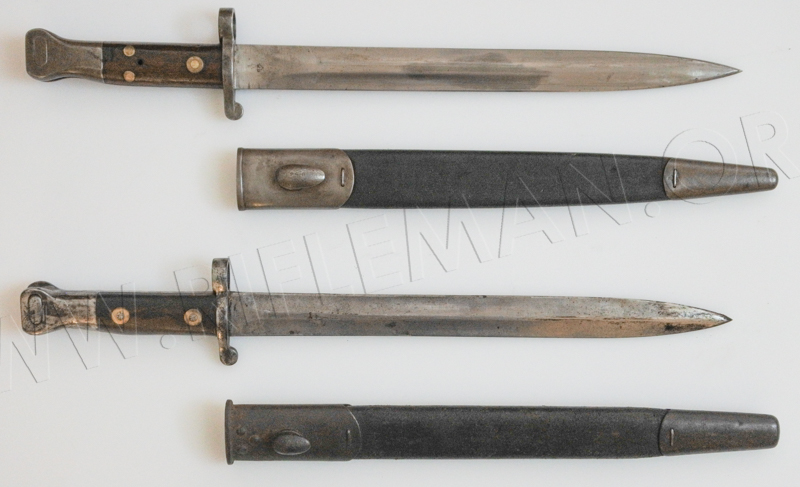
The marks of the Mk.I 1st type on the ricasso.
Left: the Ward Dept. stamp, Broad Arrow and Enfield inspector's mark
Right: the crown of Queen Victoria and the date of November 1889.
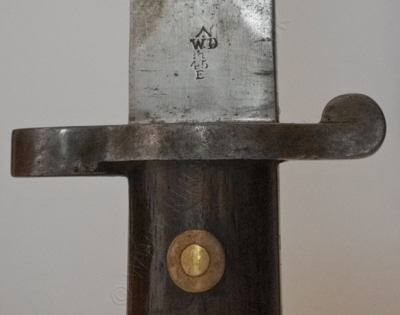
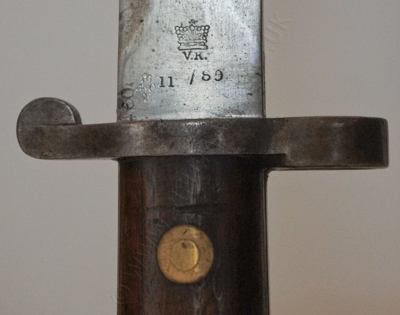
The stamps on the 2nd. type's ricasso have, for unknown reasons, been ground off, but would typically be dated for 1894-1897.
DATA TABLE - ALL MEASUREMENTS AS VIEWED EXAMPLE |
FIREARM |
IMPERIAL |
(METRIC) |
| Designation or Type : |
British Service Rifle
|
| Manufacturer : |
Birmingham Small Arms & Metal Company |
| Date : |
1892 |
| Serial No : |
56810 |
| Furniture : |
Walnut
|
| Action Type : |
Turning bolt
|
| Nomenclature or main marks: |
Magazine Lee-Enfield/Metford
|
| Calibre : |
.303inch Centre Fire |
? mm |
| Weight : |
9 lbs. 4 ozs. |
? kgs |
| Length - Overall : |
49.25 inches |
? cms |
| Length - Barrel : |
30.375 inches |
? cms |
| Pull : |
13½inches |
? cms |
| Spare row : |
|
- |
Rifling - No. of Grooves : |
7 |
|
| Rifling - Twist & Direction : |
1 turn in ? inches - RH |
? cms |
| Rifling - Groove width : |
0.0?? inches |
? mm |
| Rifling - Land width : |
0.0?? inches |
? mm |
Rifling - Groove depth at muzzle : |
|
|
| Sight - Fore : |
barleycorn on block |
- |
| Sight - Rear : |
V-notch tangent leaf |
- |
| Sight - Radius : |
21¾ inches |
? cms |
A most interesting aspect of the introduction of the first Magazine Lee-Metford rifle was a lengthy criticism of the design and manufacture of the first issued units, as compared with the preceding Martini-Henry service rifle. The criticism was presented in the House of Commons by one Mr. Majoribanks on 3rd. February 1891, and was reported in Hansard as replicated in the scrollable PDF below.
That such considerable negative opinion should have been put forward after only trialling of early rifles, is retrospectively eye-opening. In view of the subsequent longevity and sterling performance of the Lee-Metford and Lee-Enfield designs, through many marks, and at least three major following wars, it is indicative of how seriously conservative thinking can potentially set back major advances in almost any field.
In contradiction of Hansard, on 30th. April 1898 the London Illustrated News published a piece on the Lee-Metford rifle declaring it to be "The most perfect rifle in the World". It is a fascinating insight into the thoughts and opinions of the time on the Nation's latest arming of the soldiery. The image below is not searchable, but is perfectly legible if the zoom option is used.
Click image to bring up hi-res file and magnifier
The famous Bisley gunsmiths "Fultons", extant to this day,
contemporarily marketed an 'aide-memoire' in the form of a handkerchief.
As well as various drill, field and tactical instructions of the time,
it carried the then popular military music scores and lyrics for the songs of the day,
pictures of the various medals that could be awarded for fine service or bravery,
signalling information including morse by semaphore, aiming and firing instruction,
and detail of the Magazine Lee-Metford rifle itself.
It was altogether a remarkable and useful item, easily carried,
and presumably mainly intended for the volunteer rifleman.
Click image to bring up hi-res file and magnifier
In itself a rather eccentric piece in the contemporary journal The Harmsworth was published about experiments with "strange projectiles"; viz: the Metford bullet and shotgun pellets, and strangely entitled "Eccentric Bullets"
We are not sure we even fully understand this brief article, but the statistics for the Metford round are perhaps of interest.
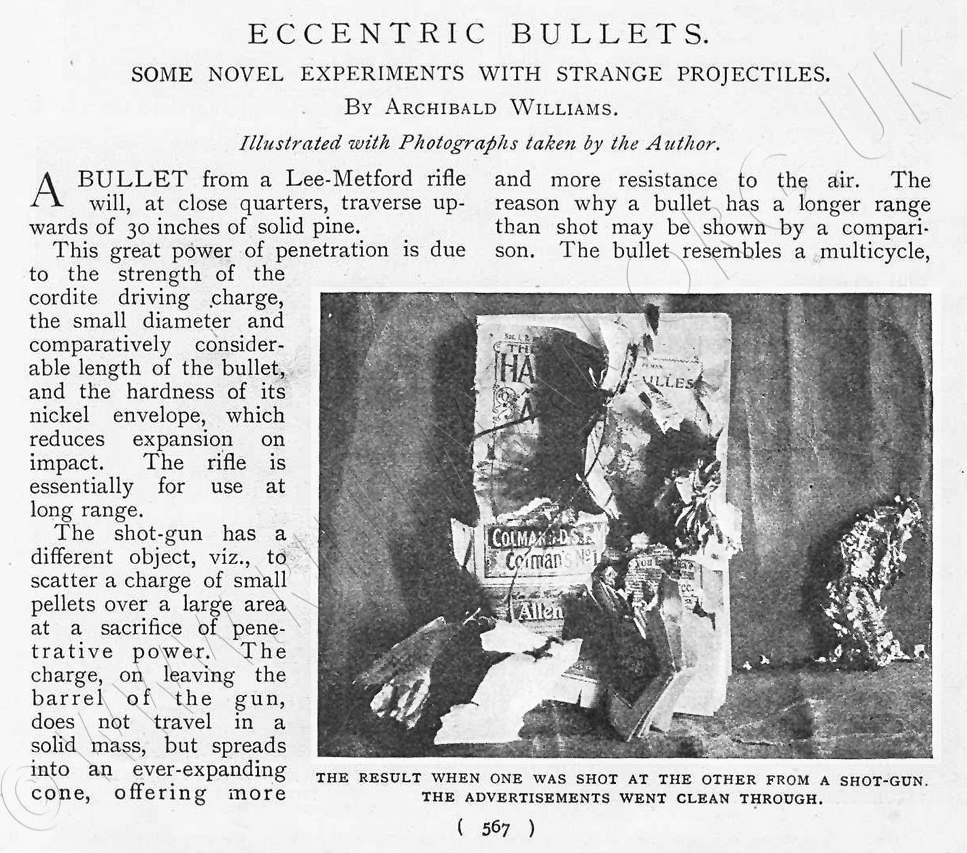
This rifle can be viewed fitted with the Wilkinson Sword Company's
"Portable Sub-Target Machine"
for musketry training without ammunition.
See also a "Long" Lee-Enfield training rifle in .22RF
and the M.L.E. rifle in the air with the Royal Flying Corps during WW1
N.B. - The original drawings for these rifles and carbines, and detailed notes are available on our page for INSTRUCTIONS FOR ARMOURERS 1897
Return to: TOP of PAGE
See this website's Raison d'être




